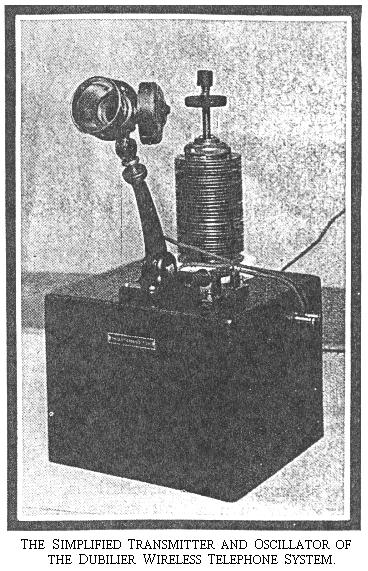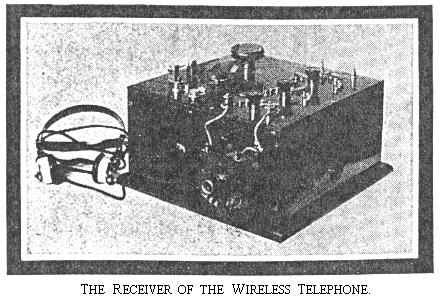Technical World Magazine, April, 1912, pages 329-331:
W I R E L E S S T E L E P H O N E F O R E V E R Y B O D Y
B y
W I L L I A M T. P R O S S E R
A WIRELESS telephone outfit in a suit-case--or in any other convenient carrying receptacle--complete, and requiring only connection at any ordinary electric-light socket to make it capable of operating over a distance of fifty miles, is the latest product of invention in this wonderful field.

To William Dubilier, a California youth of twenty-two years, belongs credit for perfecting an instrument to such a degree of nicety that it is of readily portable bulk and yet of high efficiency. With a range of something like three hundred keys and escaping many of the problems of interference, such an instrument can accomplish wonders for the individual user. Wherever sufficient current is available for lights, there the little wireless set may be put readily to work for communication over areas of trackless forest, desert or sea. That it will be the means of saving lives, when nothing else will avail is at once apparent. That it will be invaluable in new country, ahead of the wires or the regular wireless installations, in military activities and in all times and places when ordinary means of message-sending are interrupted or unestablished is easily recognizable.
Young Dubilier, inventor and electrical engineer, has made a specialty of the wireless telephone and his success in this specialty has attracted wide attention. Most of his experiments have been carried on in Seattle. He is a product of Cooper Institute, New York, where he studied while supporting himself by hard work. So he deserves, every bit, the harvest he is reaping now. His achievement is the result of scientific method and close application through a long period of experimentation and, despite his youth he has won a veritable triumph.
The Dubilier instruments are not noticeably different in principle from the wireless telephone devices of the past, but they are compact. Instead of great coils of wire and oscillators as big as a dining-room table, the Dubilier apparatus is reduced to marvelously small dimensions, while any commercial lighting circuit gives all the power that is necessary.
Mr. Dubilier is not particularly keen in exploiting his invention, his explanation being as compact as his instruments. He merely says that the electric light current passing through the new type of oscillator is rendered into electrical waves to the number of 100,000 a second, and that these affect instruments attuned to the same key within a wide radius. Simple, isn't it?

"Influential men believe in my invention as much as I do, and we plan to build a factory and manufacture my machines upon a large scale," said Mr. Dubilier in Seattle recently. "This will be, I believe, the first wireless telephone factory ever opened in America--or the world, for that matter. The machines are not costly to turn out, and we will be able to supply them so cheaply in large lots that they may be used extensively in cities, much more cheaply in rural communities than the present wire systems, for marine and coastwise work, and for special uses such as by forest rangers on the great reservations of the Rocky Mountains and Pacific Coast.
"The machines will be of particular advantage in sparsely settled districts, as in the gold-camps of Alaska. Prospectors within a radius of thirty or forty miles of civilization, for instance, will be enabled by the use of one of these light sets to keep in continual touch with what is going on, and undoubtedly many lives will be saved by the practical application of the device."
Wireless, and especially the wireless telephone, has been what might almost be called an obsession with young Dubilier ever since he was old enough to know anything about the subject at all. Born in New York in 1888 he received his early education in the public schools. His parents were not able to keep him in school through the high school course, and he left high school to secure employment. He saved his money, and later, by doing odd jobs through the course, gave himself the benefit of three years study of electrical engineering.
It was in 1904 that he began his own experimenting with the wireless telephone, and after many disappointments and discouragements he perfected one of the first pieces of apparatus of that kind. Graduating from his technical course at the eighteen he became an inspector for the Western Electric Company in New York. But wireless continued to fascinate him, and he determined to take a course in the Cooper Institute. The hours of the institute were from 9:30 until 3:30. Hurrying each day from the lecture-room to a telegraph office he delivered messages from 4 o'clock in the afternoon until midnight.
After his course was over he became chief electrician of a wireless concern, and then technical director of another. All the time he was experimenting with his own telephone, and he invented a number of minor wireless instruments. He is the author of the "Wireless Telephony" chapter in Prof. H. L. Twining's book on wireless, one of the few works of the kind in existence. His lectures on wireless attracted favorable comment. With some of the best known experts in the country his technical testimony has been sought by the law courts.

It was just a few months ago that he completed the telephone apparatus that is his great work so far. Sensitive and delicate, it yet seems to be practical in every respect. A cabinet ten inches each way, and six inches deep will hold the mechanism.
Most of the experiments with the new device have been carried on at Seattle and between Seattle and Tacoma, a distance of thirty-five miles. Conversation carries that far as clearly as on the ordinary telephone. As some of the ships of the United States navy are equipped with wireless telephones Mr. Dubilier has an excellent opportunity to compare the merits of his invention with that used by the navy department, as the Puget Sound navy yard is located about sixteen miles from Seattle. J. B. Annis, first class electrician, United States signal corps, sent this message to the inventor after one of the tests:
"A good deal plainer than the telephone we use here."
Which would seem to augur well for the invention.
Mr. Dubilier believes he can still further perfect his receiving and transmitting devices with their control system so that much more than three hundred telephones--representing that many different attunements--can be used at the same time without interfering with each other. However, even that number is a long step forward. If Mr. Dubilier does nothing more for wireless telephony, the aerial talk-transmitting systems of the future will owe him a notable debt of gratitude. And he is only twenty-two.


